College of Liberal Arts & Sciences
7D30.95 - Photomultiplier Tubes and NaI Crystals
See also 9B20.30 in Facilities Support.
The NaI crystals should be kept in a reseal able plastic bag to prevent water absorbing into and degrading the crystals. The Mu-Metal shields are made of a special alloy that helps prevent the penetration by magnetic fields. These are used routinely around photomultiplier tubes as magnetic shields.
- Mary Lowe, Alex Spiro, Peter Kutt, "Gamma Camera Imaging in an Undergraduated Physics Course", AJP, Vol. 90, #1, Jan. 2022, p. 51.
- G. C. Chikkur, M. T. Lagare, and N. Umakantha, "Fluorescence Spectrum of NaI(TI) Crystal: A Laboratory Experiment", AJP, Vol. 47, #8, Aug. 1979, p. 715.
- P. Venkataramaiah, H. Sanjeeviah, and B. Sanjeevaiah, "Energy Dependence of the Relative Halfwidth of Gamma-Ray Lines in NaI (TI) Crystals - A Laboratory Experiment", AJP, Vol. 46, # 3, Mar. 1978, p. 292.
- Donal J. Burns, James M. Reynolds, "Simple Experiment to Introduce the Photomultiplier", AJP, Vol. 44, #7, July 1976, p. 649.
- John H. Moore, Christopher C. Davis, Michael A. Coplan, "Photoemissive Detectors", Building Scientific Apparatus 2nd Edition, pp. 260 - 271.
- Stilbene Crystal, "A Crystal That Detects Nuclear Radiation (No, Really), Popular Science, Dec. 2015.
Disclaimer: These demonstrations are provided only for illustrative use by persons affiliated with The University of Iowa and only under the direction of a trained instructor or physicist. The University of Iowa is not responsible for demonstrations performed by those using their own equipment or who choose to use this reference material for their own purpose. The demonstrations included here are within the public domain and can be found in materials contained in libraries, bookstores, and through electronic sources. Performing all or any portion of any of these demonstrations, with or without revisions not depicted here entails inherent risks. These risks include, without limitation, bodily injury (and possibly death), including risks to health that may be temporary or permanent and that may exacerbate a pre-existing medical condition; and property loss or damage. Anyone performing any part of these demonstrations, even with revisions, knowingly and voluntarily assumes all risks associated with them.

